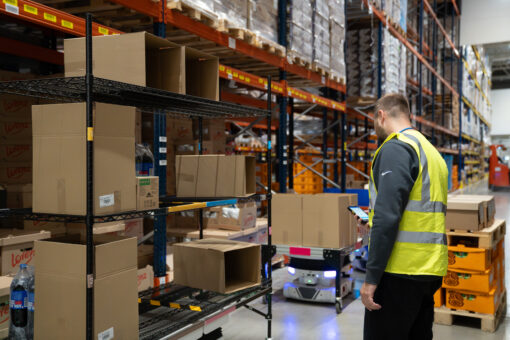WP: How to achieve 400 UPH with Locus Fast Pick
WP: How to achieve 400 UPH with Locus Fast Pick Download Now!
Navigating Warehouse Peak Season: Top eCommerce Strategies for Success
Mary Hart, Sr. Content Marketing Manager

Peak season is a busy time for retail and eCommerce warehouses around the globe, which isn’t news to anyone reading this. From the holiday shopping spree to "mini-peaks" like back-to-school or Halloween, the volume surges challenge even the most organized facilities. With consumer expectations for speed and accuracy continually rising, meeting the demands of warehouse peak season requires not just preparation but a strategic, tech-driven approach to maintain efficiency and morale.
In a recent episode of Warehouse Automation Matters, I sat down with Chris Bud "Budney" from Sequoia Group to discuss best practices for peak season success. Budney offered essential insights on topics ranging from automation to strategic labor management that can help warehouses not only survive but thrive during these demanding periods. Here’s a dive into some of the most impactful takeaways.
Top Warehouse Peak Season Challenges: Why It’s More Than Just Volume
Budney understands that one of the first, unavoidable challenges in peak season is simply dealing with volume — but volume alone isn’t the whole picture. Warehouses face a number of stress points: labor shortages, fulfillment overloads, and increased logistics costs are only the beginning. Budney noted that common problems like “insufficient warehouse capacity, higher logistic costs, [and] potential for increased returns or order errors” pile onto each other during peak season, creating what he calls “the top challenges of peak season.” Warehouses that can anticipate and plan for these issues will have a competitive edge.
For example, one of the most critical aspects of preparation involves understanding inventory management. Warehouses must ensure that their warehouse management system (WMS) is “utilizing accurate counts” before peak season hits, explained Budney. Simple mistakes like cluttered aisles or poorly planned putaway processes can quickly snowball, causing delays that could have been avoided with better planning. The strategic organization of inventory is so important, as it reduces travel time within the warehouse, increases pick efficiency, and ultimately helps teams meet order demands faster.
Pre-Season Labor Strategies for Efficiency and Morale
Warehouses, especially during peak season, often experience staffing shortages, and warehouses have the highest turnover rate with an average of 37% according to a study from last year. To address this, Budney advised that companies bring on seasonal hires early. “If you want proficient staff, you want to get them acclimated at least 30 days before peak season hits,” he noted, emphasizing the importance of giving new hires time to become efficient in their roles before the rush.
An innovative approach to managing labor during peak season is implementing “overlapping shift starts and ends.” As Budney explained, staggered shifts allow associates to wrap up tasks without the need for extended overtime, which can be a morale drainer if it becomes a daily requirement. Budney’s suggestion is simple but effective: overlapping shifts help manage workflows without pushing teams into burnout mode, a key factor in keeping warehouse morale high. “Maintaining morale and reinforcing the staff is as important as ensuring operational success,” he adds.
Leveraging AMR Automation to Stay Agile and Productive
For many warehouses, automation is no longer an option; it’s essential. Budney highlighted Autonomous Mobile Robots (AMRs) as one of the most practical and high-return automation options available. Unlike traditional conveyor systems or even autonomous forklifts, AMRs offer flexibility in deployment and faster ROI. Budney stated that his favorite automation partner is Locus Robotics, which provides a Robots-as-a-Service (RaaS) model. This setup allows warehouses to ramp up AMR usage during peak season and then return the robots afterward, making it a cost-effective solution.
But what really sets AMRs apart during peak season is their adaptability and flexibility. AMRs can handle transport and repetitive tasks, freeing up human associates to focus on picking. putaway, and managing inventory in designated areas. “By utilizing your forecasting from your ERP or WMS… you can bring in more bots to increase unit pick per hours,” Budney advised. This targeted deployment can significantly boost throughput during peak season and helps alleviate pressure on human associates.
Mastering Inventory Management: Efficiency Meets Precision
Effective inventory management is the backbone of a successful peak season and a true WMS that integrates with automation is key to ensuring real-time tracking and seamless stock replenishment. According to Budney, an optimized WMS “handles requests and responses to fulfillment, giving you your best results.” This not only minimizes errors but also enhances accuracy, which is essential when handling high order volumes.
Additionally, Budney stressed the importance of planning for high-demand items. “Analyze your inventory fast movers… and move them closer to the packing and shipping areas,” he suggested. By pre-positioning popular products, your warehouse can reduce pick time significantly and cut down transport delays. Given that about 25% of holiday shoppers begin their shopping in October, having fast movers in prime positions is critical to staying ahead of demand surges.
Forecasting and Data Analytics: A Look into the Future
Data analytics are transforming warehousing operations, providing the insights necessary to prepare for and succeed in peak season. Budney pointed out that 3D modeling and forecasting tools within ERP and WMS systems offer predictive insights, enabling warehouse managers to “project which products will be moving in weeks to come” and adjust stock levels accordingly. By using data to drive inventory placement and workflow organization, warehouses can prevent stockouts and avoid operational bottlenecks.
Moreover, data from digital twins — virtual models that replicate real-world operations — enable warehouses to run test scenarios and optimize workflows. As Budney put it, running these tests allows teams to “see what strategies work best” and make informed decisions about how to adjust workflows based on expected peak volumes.
Beyond the Holidays: Preparing for Year-Round Peaks
While the holiday season is often the most intense peak period, other mini-peak times are also gaining importance. “Sales events through social sales… drive similar spikes,” Budney explained, referencing newer trends like flash sales or influencer-driven product promotions. Using forecasting tools in ERP and WMS systems, warehouses can predict these events and prepare for the surges by adjusting stock levels and staffing in advance. Being proactive instead of reactive helps mitigate sudden, intense spikes that could otherwise derail operations.
Meeting Consumer Expectations with Speed, Accuracy, and Sustainability
Today’s consumers expect quick, accurate, and sustainable order fulfillment. Warehouses need to rise to this challenge by leveraging technology that enhances accuracy while reducing environmental impact. “Amazon has set the pace for same-day delivery… with automation scanning products directly into a bin or container, you can really ensure nearly 100% accuracy all the time,” Budney noted. This precision is increasingly becoming the industry standard, as consumers demand both speed and accuracy.
Moreover, sustainability can be enhanced by using AMRs and efficient WMS systems that reduce the need for excess packaging, wasted time, and fuel. Meeting these expectations can boost a warehouse’s reputation and attract more customers — a win-win situation for all.
Resilience in the Face of Change
Peak season success ultimately comes down to flexibility and foresight. Budney summed up the importance of preparation by saying, “There’s always something that we can do to help people out,” reminding us that warehousing success isn’t just about meeting the current demand but also preparing for what’s next. By refining processes, optimizing technology, and investing in the right tools, warehouses can set themselves up not only for a successful peak season but for a sustainable, resilient future.
As peak season rolls around, these strategies serve as a playbook for handling the unique challenges it brings. With the right mix of labor planning, automation, data analysis, and inventory management, warehouses can turn peak season from a stress point into a strategic advantage, setting themselves up for operational success now and in the years to come.
Take a listen to the full episode of Warehouse Automation Matters here.




